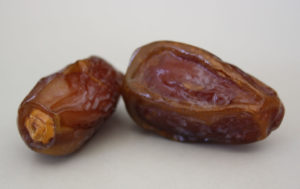By GARY ALLEY
September 2014
Deuteronomy is a book of expectations. In this final book of the Pentateuch, God stokes the Israelites’ expectations concerning their entrance into the long-awaited “Promised Land”, while at the same time, He explains the rules that they are expected to follow. One of these expectations is the agricultural bounty of the land of Canaan, often summed up by the so-called seven species. During the time of Jesus, only these seven varieties[1] were presented in the Temple at Jerusalem as offerings of the first fruits festival (Ex 34:26).
“For the Lord your God is bringing you to a good land, a land of brooks, springs, and fountains flowing forth in valleys and hills, a land of wheat, barley, grapevines, figs, and pomegranates, of olive oil and honey (Dt 8:7-8).”
HONEY is a sweet food which is obtained from several sources, the most prominent being bees’ production from flower nectar. Honey was used as a multifaceted, diverse symbol within the biblical text. The Bible’s well-known description of Canaan, as a “land flowing with milk and honey,” has often been interpreted as a testimony to the Land’s abundance and blessing. Though, on the other hand, the uncultivated, inconsistency of honey was used as a sign of social collapse (Isa 7:22-23). The use of honey was forbidden for sacrifice (Lev 2:11), though its sweetness was compared to the wisdom and word of the Lord.[2]
Probably the most famous biblical story involving honey is Samson’s riddle to the Philistines after he found wild honey[3] in the carcass of a lion that he had previously slain (Jud 14:12-18). A lesser known story is King Saul’s son, Jonathan, finding and eating wild honey during a campaign against the Philistines. His taste of honey nearly brings about his death because of an oath sworn by his father (I Sam 14:24-45). John the Baptist’s diet of locust and honey has often been highlighted as an austere and feral lifestyle (Mt 3:4).
In Jewish tradition, honey plays an important role in the celebration of Rosh haShanah. Apples are dipped in honey representing hopes for a “sweet” New Year.
In the Ancient Near East, honey was also made from the juice of different fruit, like grapes, dates, and figs. This type of man-made fruit honey is still produced today in the Middle East being called dibs in Arabic. Until recently, many scholars[4] assumed that dibs date honey was probably what the Bible referred to when it spoke of Canaan “flowing with milk and honey”[5] since no remains of a beehive industry had ever been found in Israel or anywhere in the Ancient Near East. Yet, starting in 2005, a startling discovery of approximately one hundred beehives housing an estimated million bees was made at Tel Rehov, an Israelite settlement from the time of the biblical monarchy. (For a video, here.) While this finding has reignited the debate of “which honey” the Bible refers to, perhaps we could make room at our biblical table for both.
[1] Mishna Bikkurim 1,3
[2] Ps 19:9-10; Pr 24:13-14
[3] Other examples of undomesticated honey: Dt 32:13; Ps 81:16
[4] Also rabbinic tradition, see Jerusalem Talmud Bikkurim 1:3
[5] The phrase “ flowing with milk and honey” appears 20 times in the Bible. Scholars have argued that this phrase “flowing with milk and honey” refers to human production, storage, and trade of honey. Many have seen dibs honey as more conducive to this end. Regarding honey trade, see Gen 43:11 and Ezk 27:17.
![]()
